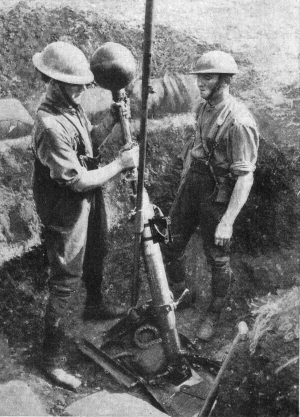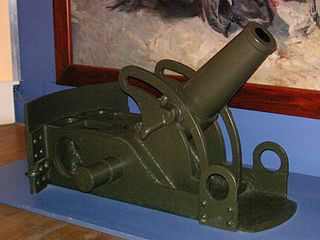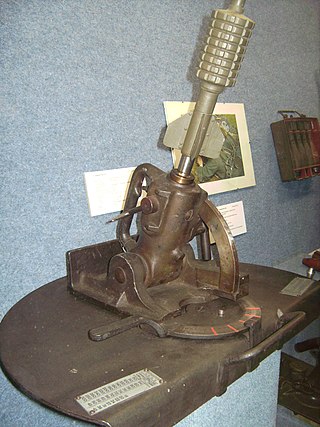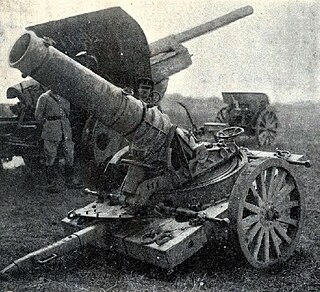
A mortar is today usually a simple, lightweight, man-portable, muzzle-loaded cannon, consisting of a smooth-bore metal tube fixed to a base plate with a lightweight bipod mount and a sight. Mortars are typically used as indirect fire weapons for close fire support with a variety of ammunition. Historically mortars were heavy siege artillery. Mortars launch explosive shells in high-arching ballistic trajectories.
This article explains terms used for the British Armed Forces' ordnance (weapons) and ammunition. The terms may have different meanings depending on its usage in another country's military.

Minenwerfer is the German name for a class of short range mine shell launching mortars used extensively during the First World War by the Imperial German Army. The weapons were intended to be used by engineers to clear obstacles, including bunkers and barbed wire, that longer range artillery would not be able to target accurately.

The Newton 6-inch mortar was the standard British medium mortar in World War I from early 1917 onwards.

The 2 inch medium trench mortar, also known as the 2-inch howitzer, and nicknamed the "toffee apple" or "plum pudding" mortar, was a British smooth bore muzzle loading (SBML) medium trench mortar in use in World War I from mid-1915 to mid-1917. The designation "2-inch" refers to the mortar barrel, into which only the 22 in (560 mm) bomb shaft but not the bomb itself was inserted; the spherical bomb itself was actually 9 in (230 mm) in diameter and weighed 42 lb (19 kg), hence this weapon is more comparable to a standard mortar of approximately 5–6 in (130–150 mm) bore.

The 240 mm trench mortar, or Mortier de 240 mm, was a large calibre mortar of World War I. An original French design, it was developed by Batignolles Company of Paris and introduced in 1915.

The Mortier de 58 mm type 2 or Mortier de 58 mm T N°2, also known as the Crapouillot or "little toad" from its appearance, was the standard French medium trench mortar of World War I.

The 9 cm Minenwerfer M 14 was a light mortar used by Austria-Hungary in World War I. Originally named the '1-kg Minenwerfer', it was designed by the Army's own Technisches und Administratives Militär-Komitee (TMK) in an effort to quickly satisfy the demand from the front for a light mortar.
In military munitions, a fuze is the part of the device that initiates its function. In some applications, such as torpedoes, a fuze may be identified by function as the exploder. The relative complexity of even the earliest fuze designs can be seen in cutaway diagrams.

The 21 cm Kanone 39 was a Czech-designed heavy gun used by the Germans in the Second World War. Two were built before the Germans occupied Czechoslovakia in March 1939 and seized the rest of the guns and kept it in production for their own use, eventually building a total of 60 guns for themselves. They saw action in Operation Barbarossa, the siege of Odessa, siege of Leningrad and the siege of Sevastopol and were used on coast defence duties.
The Type 3 81 mm mortar is a smooth bore, muzzle-loading 81 mm (3.19 in) infantry weapon used by the Imperial Japanese Army during World War II. The Type 3 designation was given to this gun as it was accepted in the 3rd year of Emperor Taishō's reign (1914).

Albrecht mortars or Albrecht Schwerer Minenwerfers were a series of wooden heavy mortars used by the Imperial German Army during the First World War.

The 21 cm Mörser 99 was a German siege mortar built by Krupp which served during World War I. The mortar utilized a new nickel-steel alloy of greater strength than other cast cannons, though it lacked a recoil mechanism. While the gun was more effective than previous models, it was soon phased out because of improved field artillery and counter-battery fire, though it remained in service in limited numbers throughout the war because of heavy German losses.

The Mortier de 75 modèle 1915 Schneider was a French trench mortar designed and built by Schneider that saw action with the French and Belgian Army during the First World War.

The 24 cm schwere Flügelminenwerfer IKO or 24 cm sFIMW IKO was a heavy mortar used by the Imperial German Army during the First World War.

The kleineGranatenwerfer 16 or Gr.W.16(Small Grenade Launcher Model 1916) in English, was an infantry mortar used by the Central Powers during the First World War. It was designed by a Hungarian priest named Father Vécer and was first used by the Austro-Hungarian Army in 1915. In Austro-Hungarian service, they received the nickname "Priesterwerfers". In 1916 Germany began producing a modified version under license for the Imperial German Army.

The Mortier de 58 T N°1 sometimes referred to as Lance Torpilles was an early French medium trench mortar of World War I. Built in small numbers it was a transitional type in the development of later French mortars.

The 24 cm schwere FlügelMinenWerfer Albrecht, or 24 cm sFIMW 17 Albrecht, was a heavy mortar used by the Imperial German Army during the First World War.

The Mortier de tranchee de circonstance Cellerier or Cellerier Mortar was an early French light infantry mortar of World War I. The name roughly translates to (Cellerier Improvised Trench Mortar) in English.

The Mortier de 58 T N°1 bis sometimes referred to as Lance Torpilles was an early French medium trench mortar. It was used by both the French Army and Italian Army during the First World War.


















